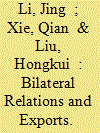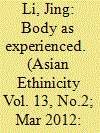|
|
|
Sort Order |
|
|
|
Items / Page
|
|
|
|
|
|
|
| Srl | Item |
| 1 |
ID:
190401


|
|
|
|
|
| Summary/Abstract |
This paper investigates the effect of bilateral relations on exports using data from Google Global Data. It finds that bilateral relations significantly reduced the negative effect of cultural distance on exports, indicating that they can promote exports by reducing trade costs. The paper finds that higher average Goldstein scores of events correlated with more exports and that bilateral relations had a larger effect on trust-intensive products, indicating that positive relations built trust and decreased the emotional distance between trading partners. The results also show that bilateral relations promoted exports at both the intensive and extensive margins but with a greater effect on the latter. Finally, bilateral relations had a greater positive effect on developing countries than on developed ones. The results were qualitatively unchanged when endogeneity issues and robustness concerns were considered.
|
|
|
|
|
|
|
|
|
|
|
|
|
|
|
|
| 2 |
ID:
111532


|
|
|
|
|
| Publication |
2012.
|
| Summary/Abstract |
This article looks at the filming of the Dai river bathing custom by the media professionals for tourism promotion in Xishuang Banna, China. It speaks to the previous scholarships that have studied the Otherness of ethnic minorities in China's mainstream and popular representations. Yet this case contextualizes this issue in the era of China's domestic tourism, when ethnic cultures and bodies are increasingly put on display, experienced, and (re-)produced through individualized, immediate, embodied encounters in tourist zones. By taking embodied experiences to the center, this article studies the touristic representation of ethnic minorities as China's national Others from an angle of embodiment. It inquires how the embodied experiences of both media professionals and Dai bathers at the filming constitute the very process during which Otherness, difference, and selfness are perceived, actualized, and (re-)produced in localized reality and at the grassroots level.
|
|
|
|
|
|
|
|
|
|
|
|
|
|
|
|
| 3 |
ID:
113446


|
|
|
|
|
| Publication |
2012.
|
| Summary/Abstract |
Government policy continues to play a crucial role in the development of wind power industry in China. The 2005 "Renewable Energy Law" and related policies have driven the rapid increase in wind power installed capacity in China over the past half-decade, with capacity doubling annually since 2005. However, a large number of wind farms generate electricity well below their installed capacity, resulting in considerable wastage of resources. Non-grid-connected wind power theory proposes that large-scale wind power output does not necessarily have to be fed into the grid, but can be used directly in industrial production. Thus, the use of the theory can promote the sustainable development of the wind power industry by obviating the need for power grid. In this paper we analyze the influence of government policy on wind power industry from the perspective of institutional change, by employing the basic theories of new institutional economics. A development model for non-grid-connected wind power is proposed in order to implement institutional change in accordance with the specific characteristics of wind power industry in China. This model requires the government to play an active role in institutional development by increasing economic efficiency in order to promote the sustainable development of wind power.
|
|
|
|
|
|
|
|
|
|
|
|
|
|
|
|
| 4 |
ID:
182764


|
|
|
|
|
| Summary/Abstract |
We construct a pseudo panel sample from the China General Social Survey to study the inequality of opportunity in China. The pseudo panel enables us to control for cohort-specific heterogeneities when estimating the Mincer equation, and the results show that individual circumstances play a prominent role in determining income advantage. Counterfactual analysis further reveals the importance of cohort-level circumstances: individual circumstances account for less than 10% of the observed income inequality, whereas equalizing both the individual circumstances and the cohort fixed effects reduces income inequality by 30%. Among the individual circumstances we examine, gender and paternal characteristics contribute more to income inequality than does hukou of birth. Subsample analysis shows that China's western provinces exhibit the highest inequality of opportunity and that the inequality of opportunity among younger cohorts is smaller than that among older cohorts.
|
|
|
|
|
|
|
|
|
|
|
|
|
|
|
|
| 5 |
ID:
051518


|
|
|
|
|
| Publication |
Mar-Apr 2004.
|
|
|
|
|
|
|
|
|
|
|
|
|
|
|
|
| 6 |
ID:
170087


|
|
|
|
|
| Summary/Abstract |
Income distribution is perceived to affect crime (Becker 1968; Thurow 1971; Merlo 2003). Consequently, economists have been modeling crime employing inequality indicators as one of the explanatory variables, yielding mixed results. This paper argues that income polarization rather than inequality indicators should be used instead. Technically, in addition to income gaps that are measured by inequality indicators, the recently developed polarization index of Duclos, Esteban, and Ray (2004) also captures clustering, which implies social segregation and immobility, both potentially causing social tensions and conflicts. Thus, this polarization index is expected to be a better variable in explaining crime. To substantiate our arguments, provincial panel data from China are used to model the crime–income distribution relationship. Income polarization is found to be positively and significantly associated with crime. When both income polarization and inequality indicators are included in the models, the former remains a positive and significant determinant while the latter becomes insignificant.
|
|
|
|
|
|
|
|
|
|
|
|
|
|
|
|
|
|
|
|
|